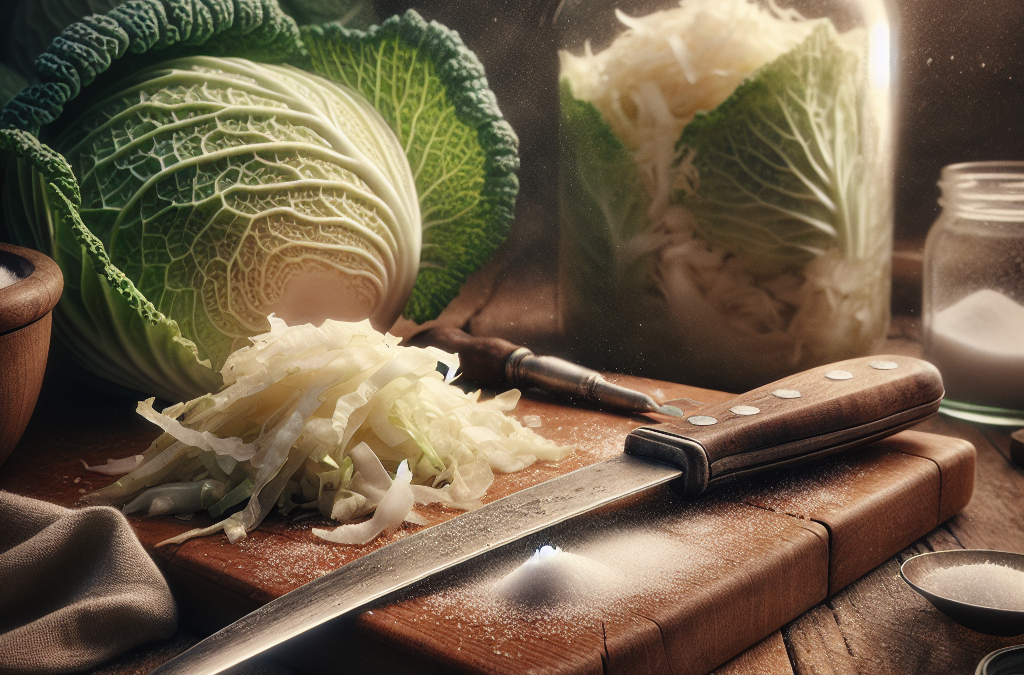Choosing the Right Cabbage
Understanding Varieties
First things first, choosing the right cabbage is essential for crafting that delicious, tangy sauerkraut. There are many types of cabbage out there, but my go-to is green cabbage. It’s the classic choice and really lends itself to fermentation beautifully. While you could use red cabbage for a vibrant twist, green cabbage has that right amount of crunch and sweetness that I absolutely love.
When selecting your cabbage, look for heads that are dense and heavy. I think of it like picking the perfect watermelon. You want that solid feel, which indicates freshness. Avoid any with brown spots or blemishes, as those could affect the flavor and quality of your sauerkraut.
Pro tip: If you can find organic cabbage, definitely go for it! It’s free from the pesticides and chemicals that can sometimes sneak into our food. Plus, it just feels better knowing I’m using something grown with care.
Local vs. Imported
I’ve tried both local and imported cabbages, and while they each have their merits, I’d strongly recommend sourcing local cabbage whenever possible. Not only does it support local farmers, but you usually get fresher produce that hasn’t spent days in transit. There’s something special about using ingredients that are fresh from the earth.
Imported cabbages can sometimes have that shelf-life crunch, but they might not have the robust flavor that local varieties do. In my experience, I’ve noticed the taste of my sauerkraut is just better when I use local cabbage sourced from farmers’ markets.
Plus, shopping at local markets is super fun! You can interact with the growers, hear their stories, and sometimes get tips on the best ways to prepare their produce.
Preparing the Cabbage
Once I’ve selected my cabbage, it’s time to chop! I like to remove the outer leaves and give the cabbage a good rinse. Then, I slice it in half and chop it into thin strips. The thinner, the better, if you ask me. This will help with the fermentation process, allowing those flavors to develop beautifully.
After chopping, I toss the cabbage into a large mixing bowl and add some salt. The salt draws out the moisture from the cabbage—important for creating that brine that’s key to fermentation. I love getting in there with my hands, squeezing and massaging the cabbage to really get that moisture going.
Don’t skip this step! It’s all about using your hands and connecting with the food. I usually spend a good 5-10 minutes just massaging it in my bowl, feeling like I’m connecting with the cabbage on a different level.
Salting and Massaging
Finding the Right Ratio
This part is crucial. I’ve learned over the years that the right amount of salt makes all the difference. Generally, I use about 2 tablespoons of salt for every 5 pounds of cabbage. Salting helps to kickstart the fermentation process while also preserving the crunch.
But it’s not just about throwing it in there. I quite like to dissolve the salt in some water first before mixing it in. This way, I can ensure an even distribution throughout the cabbage. There’s something oddly satisfying about watching the salt crystals disappear into the water!
Sometimes, if I feel adventurous, I’ll add in some caraway seeds or juniper berries for an extra flavor kick. It’s all about experimenting with what I love—cooking is about joy, after all!
The Softening Process
As I’ve mentioned, massaging the cabbage not only helps with flavor but really aids in that softening process. You can actually feel the cabbage breaking down as you work it. I find it a bit therapeutic—a nice break from the chaos of everyday life.
After I’ve gotten a good amount of moisture released, I’ll leave the cabbage to rest for about 30 minutes. The longer it sits, the more water it releases. Just be patient—this isn’t a rush job!
Sometimes I get impatient and sneak in a taste. It’s amazing how quickly the flavors start to develop even at this stage. I can’t help but get excited about what’s coming next!
Tasting and Adjusting
As someone who loves experimenting in the kitchen, I always taste my salted cabbage before proceeding. The flavor should be pleasantly salty but not overpowering. If it seems a bit too salty, I’ll sprinkle in a touch more fresh cabbage to balance it out.
Remember, this isn’t an exact science; it’s all about what you like! Everyone has different tastes, so don’t be afraid to adjust as needed. I once added a hint of garlic to one batch, and it turned out to be a favorite among my friends. Go crazy!
By the end of this phase, I’m usually pretty darn happy with how my cabbage is tasting. That’s when I know it’s ready to move to the next step.
Packing into Jars
Choosing Your Containers
I love packing my sauerkraut into mason jars. They’re perfect for fermentation since they create a tight seal. Depending on how much cabbage I have, I might use pint or quart-sized jars. The key here is to ensure that there’s enough room for the cabbage to expand as it ferments.
Before packing, I make sure my jars are super clean. It’s a bit of a hassle to wash and sanitize, but a clean environment is essential for good fermentation. Trust me, you don’t want any unwanted bacteria messing with your creation!
Once I’ve got my jars ready, it’s time for the fun part—packing! I use a wooden spoon or a muddler to press down the cabbage, ensuring that the brine covers it completely. This helps create that environment needed for good fermentation.
Creating a Fermentation Weight
Sometimes, I’ll use a fermentation weight to help keep the cabbage submerged in the brine. This keeps it from floating, which can be important for preventing mold. If you don’t have a weight, you can use a clean stone wrapped in cheesecloth as a DIY solution.
It’s like creating a mini-cabbage fortress in each jar. Once everything is packed nicely, I make sure to leave some headspace—about an inch from the top—to allow gases to escape as the fermentation process kicks in.
And then, it’s lid time! I usually just cover it lightly; I want there to be some ventilation while still providing a bit of protection.
Laying Down for Fermentation
Once my jars are packed, I place them in a cool, dark spot in my kitchen. A cabinet works perfectly, away from direct sunlight. It’s important that the temperature stays between 60°F to 75°F—too cold, and it might not ferment properly; too warm, and it could spoil.
Each day, I check on my jars for bubbles and any signs of activity. You’ll see the brine bubbling, and I can’t help but smile seeing this fermentation magic happen. It’s like a science experiment you can eat!
The wait is the hardest part, usually anywhere from 1 to 4 weeks, but trust me, it’s so worth it. The flavors deepen and develop, and the smell, oh man, it’s incredible to see (and smell) the transformation happening right before my eyes.
Finishing and Enjoying Your Sauerkraut
Tasting for Fermentation
After about a week, I start tasting my sauerkraut to see if it’s reached the level of tanginess I crave. This is the fun part! Depending on my desired flavor, I might let it ferment for another week or two. The longer it ferments, the more pronounced that sour flavor becomes.
If ever I find it’s too sour for my taste, I can always balance it with dishes that are rich and fatty, like a sausage or a creamy potato salad. It’s all about finding what works for your palette!
I like to think of tasting as the final approval. After all, I’m the one who gets to eat it, right? Once it’s just right, I know it’s time to move forward.
Storing Your Sauerkraut
Once I’m happy with the flavor, my homemade sauerkraut goes directly into the fridge. This slows down fermentation and preserves that delightful tang. It can last for several months – if it lasts that long in my household!
To prevent gas build-up, I recommend loosening the lids occasionally. A little fizz is great but too much can cause a mess. No one wants a sauerkraut explosion in the fridge!
Honestly, I can only keep it around for so long because I’m always finding new ways to incorporate it into meals—topping off tacos, adding to sandwiches, or just enjoying it straight up!
Pairing and Enjoying
The best part about making sauerkraut is the creativity that follows. I love pairing it with grilled meats, like bratwurst, or tossing it into stir-fries. The tanginess adds a flavor layer that elevates any dish.
Sometimes I’ll throw a scoop on top of a simple salad—it adds that necessary crunch and zest. I also enjoy it with some avocado and a sprinkle of chili flakes on toast. It’s so versatile, and it feels so great to use my own creation in different meals.
Honestly, it’s like I’m becoming a fermented-food chemist right in my kitchen! The more I experiment, the more I find new flavor pairings that work splendidly. It’s a culinary adventure and I’m here for every single bite!
Frequently Asked Questions
1. How long does it take to make sauerkraut?
The fermentation time can vary quite a bit, but generally, you’re looking at about 1 to 4 weeks. It all depends on how tangy you want it—shorter time equals less sour, and longer time gives you that extra kick!
2. Can I use other vegetables besides cabbage?
Absolutely! Fermentation isn’t just for cabbage. I’ve had great luck fermenting carrots, radishes, and even cucumbers. Feel free to mix and match your favorite veggies!
3. What’s the best way to store sauerkraut?
Once your sauerkraut is ready, pop it in the fridge in sealed jars. It’ll keep for several months if stored correctly. Just remember to crack the lid occasionally to release some gas build-up!
4. Can I ferment with different types of salt?
Of course! Just make sure it’s non-iodized salt—like sea salt or kosher salt—because iodized salt can interfere with the fermentation process. The key is to avoid additives!
5. What if my sauerkraut has mold?
Don’t panic! It’s not unusual to see a bit of mold at the surface. As long as the brine is covering the cabbage, you can simply skim off the mold and enjoy your sauerkraut. Just make sure nothing feels or smells off!





